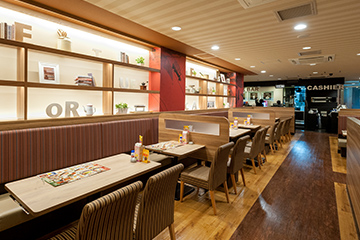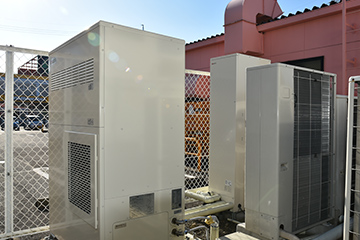Policy and Approach
Skylark Group will work to reduce CO2 emissions in order to help create a decarbonized society.
- Engage in energy-saving activities at our stores, central kitchens and headquarters.
- Work to reduce gasoline consumption in home and store deliveries, and to introduce environmentally friendly vehicles.
- Actively seek to introduce renewable energy.
Climate Change Countermeasures
To contribute to measures against global warming, we have set a greenhouse gas emission reduction target aligned with the Paris Agreement's goal of limiting the increase in global temperature to 1.5 degrees Celsius above pre-industrial levels. We actively promote investment in low-carbon technologies, such as the introduction of renewable energy and investment in energy-saving equipment, and ensure transparency by disclosing information in accordance with the TCFD recommendations.
Furthermore, progress on decarbonization-related KPIs and initiatives is reported to and shared with the Board of Directors on a quarterly basis.
Specifically, we are promoting the following initiatives:
1.Set targets for reduction of greenhouse gas emissions
- Set science-based GHG emission reduction targets and periodically evaluate progress.
- We will strengthen cooperation with related companies to reduce emissions throughout the supply chain.
2.Investment in low-carbon technologies
- Analyze emissions by business characteristics and supply chain as a whole to identify areas of focus.
- Invest in low-carbon technologies, including the installation of energy-saving equipment and increased use of renewable energy.
3.Climate change risk assessment and response:
- Evaluate the risks and opportunities that climate change presents to our business and develop appropriate response measures.
- We will enhance disclosure and ensure transparency regarding climate change.
4.Collaboration with stakeholders:
- We will work with all stakeholders, including investors, customers, employees, and local communities, to promote climate change action.
- We will promote dialogue on climate change and work together to achieve a sustainable society.
Through these efforts, we will contribute to achieving the goals of the Paris Agreement and help realize a sustainable society.
Targets
Short-term target Unit:t-CO2
| Mid-term target |
By 2030
Scope 1 50.4% reduction from 2018
Scope 2 50.4% reduction from 2018
Scope 3 30.0% reduction from 2018
Scope 1+2 50.4% reduction from 2018
Scope 1+2+3 36.1% reduction from 2018
Scope 3 FLAG 36.4% reduction from 2018
|
| Long-term target |
By 2050
Scope 1+2+3 Reduce CO2 emissions to net zero
(90.0% reduction from 2018 levels, with residual emissions to be neutralized by carbon removals) |
Supplementary Information
- Short-term, medium-term, and long-term targets are based on government policy and SBT (Science Based Targets) standards, respectively.
- Scope of short-, medium-, and long-term targets is consolidated (including overseas and subsidiaries)
Risks and Opportunities
Indicators/KPIs
Internal Carbon Pricing
In 2024, Skylark Group introduced an Internal Carbon Pricing (ICP) system to incentivize reductions in greenhouse gas emissions. We have set our internal carbon price at JPY 15,365/t-CO₂, using external prices as a reference (a shadow price). This price is used to guide investment decisions aimed at achieving our climate-related targets, including the promotion of low-carbon investments such as energy-efficiency measures and solar power generation facilities, the procurement of electricity from renewable sources, and the reduction of emissions in our upstream value chain. Through this system, we will advance our investment decision-making and risk assessment processes that take climate change into account.
Overview of Skylark Holdings Co., Ltd. Internal Carbon Pricing (ICP)
- Internal Carbon Price : JPY 15,365/t-CO₂
- Scope of Application : Capital investments associated with increases or decreases in CO₂ emissions (Scope 1, 2, and 3).
- Method of Application : For applicable capital investments, the internal carbon price is used to calculate a notional carbon cost. This cost is compared with the initial investment to inform decision-making, budget formulation, and corporate strategy. The ICP is also utilized for conducting stress tests on investments and for evaluating the financial impact of climate-related risks.
Contribution to Reductions
As part of our commitment to realizing a sustainable society, Skylark Group strives to reduce its environmental impact across all our restaurants.
As one of these initiatives, we implemented the "Komamedori Project" at all "Shabu-Yo" all-you-can-eat shabu-shabu restaurants to reduce food waste. By proposing ways for customers to eat that reduce leftovers, we addressed the issue of food loss and contributed to an annual reduction of 169.8 tons of CO2.
In addition, to conserve paper resources, we have promoted the digitalization of receipts. We introduced a system that allows customers to choose whether or not they need a receipt, which has resulted in an annual reduction of 132.2 tons of CO2.
The combined CO2 reduction from these initiatives amounts to 302 tons annually.
*Calculated as the total of Scope 3, Categories 1 and 5, based on the amount of food loss reduction from the Komamedori Project (44.13 t/year) and the reduction in receipt paper from digitalization (74.66 t/year).
Examples of Action
Introducing LED Lighting

We are actively introducing LED lighting in our stores with the aim of reducing CO2 emissions associated with electricity consumption. At the six new restaurants that have opened mainly in station-front areas, LED lighting is used for all lighting, including customer seats and kitchens. As a result, the amount of power consumed by store lighting is reduced to one-eighth of that of a regular store, leading to a reduction in CO2 emissions. We are introducing LED lighting not only to new stores but also to existing stores, to help realize more environmentally friendly stores.
Introduction of Commercial Fuel Cells

In December 2017, we introduced a commercial fuel cell (Kyocera's 3kW SOFC System) at the Bamiyan Kuniyoshida store in Shizuoka Prefecture. This is the first family restaurant to introduce this model of fuel cell. We have installed these fuel cells at four stores in Shizuoka Prefecture, and by August 2019, we have introduced them at five new Bamiyan stores in Tokyo. The SOFC system is a commercial gas cogeneration system that uses electricity generated by a chemical reaction between hydrogen extracted from city gas and oxygen in the air, and uses the heat generated during power generation for hot water supply.
At stores that have introduced commercial fuel cells, energy conservation and CO2 reduction are achieved by effectively utilizing heat for kitchen equipment and electricity for in-store lighting. We will continue to consider expanding the number of stores that use this system.
Initiatives to Realize a CFC-free and Decarbonized Society
With the aim of reducing greenhouse gas emissions, we introduced a hamburger freezer system at our Nishinomiya central kitchen and an ice cooling system at our Sendai central kitchen, utilizing a Ministry of the Environment project in fiscal 2019 to accelerate the introduction of energy-saving natural refrigerant-based equipment for the early realization of a CFC-free and low-carbon society.
A reduction of approximately 300 tons in CO2 emissions per year is expected from the hamburger freezer at Nishinomiya, and approximately 260 tons per year from the chiller unit in Sendai.
Going forward, we will continue to promote the introduction of equipment with a low environmental impact.
Nishinomiya Central Kitchen's Hamburger Freezer System
Sendai Central Kitchen's Ice Cooling System
Introduction of Eco-Chopsticks

As another initiative to reduce CO2 emissions, we are using eco-chopsticks, which are chopsticks that can be used repeatedly instead of disposed after a single use, with the aim of reducing waste and care for the environment.
Examples of Responses to Risks Arising from Climate Change

We are responding to the risks posed by climate change from a variety of angles.
In September 2021, Jonathan developed and sold a meat-free hamburger made with soy meat. As methane gas produced in cow stomachs has a greenhouse effect about 25 times that of carbon dioxide, meat has a significant impact on global warming, so we developed a delicious product that utilizes alternative proteins such as soybeans. We view the inability to obtain the same foodstuffs at lower prices as today due to climate change as one of the future risks of climate change, and we are actively researching, developing, and offering menus that utilize alternative ingredients as a response to this risk.
This product is also described in the digital menu book as "a protein source that is friendly to the future of the earth compared to livestock farming, which has an environmental impact," and we aim to promote environmentally friendly food production together with our customers.
CO₂ Reduction Subcommittee
As a subordinate organization of the Group Sustainability Committee, the CO₂ Reduction Subcommittee was established in 2023 to work across the entire company to reduce energy consumption and CO₂ emissions. The subcommittee has been working to reduce energy consumption and CO₂ emissions through the following initiatives.
Accurate Calculations
In 2023, in addition to Scope 1, 2, and Category 1 of Scope 3 for our CO₂ emissions, we also obtained third-party assurance for our energy use. In 2024, we have further expanded this scope to include Categories 2 and 3 of Scope 3.
Furthermore, by obtaining accurate data for each of the Group's facilities, we are able to identify facilities with high energy consumption and opportunities for improvement, which leads to reduction measures.
Reduction KPIs Setting
Based on accurate calculations of CO₂ emissions and energy consumption, we set annual KPIs in accordance with SBT (Science Based Targets) standards. In addition to a company-wide KPI to improve energy consumption by an average of 1% or more per year in terms of basic unit, each store and factory has its own annual KPI for electricity and gasoline, and the progress of these KPIs and efforts to reduce energy consumption are reported to the Sustainability Committee on a quarterly basis.
『Energy-Related Usage Reduction KPIs and Results』
Initiatives to Reduce
As an example of our initiatives, we opened an eco-friendly store with virtually zero greenhouse gas emissions, using solar power, CO₂-free electricity, carbon neutral gas, and EV bikes for home delivery.
『Environmentally Conscious Model Store』
We are actively switching to solar power generation as a renewable energy source in our factories and stores, and are working to introduce it to 100 facilities in 2024, setting this as a KPI.
『Installed On-Site Self-Consumption Solar Power Generation Service』
『Introduced Off-site PPA Service Using Solar Power Generation』
In order to achieve the 2030 KPI, we are also considering offsetting CO₂ that cannot be covered by the introduction of solar power generation by purchasing carbon credits.
Training for Employees
We have supplemented knowledge and shared examples of reduction measures by holding online study sessions for store employees and regularly sending out videos with a message from the president to share successful examples of energy reduction measures with stores. In addition, reduction measures and KPIs are determined for each individual store during monthly meetings with superiors and are linked to actions. In this way, we are strengthening education and training to raise employee awareness for reducing energy consumption.
Participation in the "HTT Initiative Promotion Declaration" by the Tokyo Metropolitan Government
Our company endorses the "HTT" (reduce, create, and store electricity) activities promoted by the Tokyo Metropolitan Government, as well as efforts toward realizing a decarbonized society. Accordingly, we have registered as an "HTT Initiative Promotion Declaration Enterprise.“
T Initiatives to "Create" Electricity
We are promoting the realization of a decarbonized society with the goal of achieving net-zero CO₂ emissions by 2050. Under the Group Sustainability Committee and through the CO₂ Reduction Subcommittee, we are installing solar power generation systems at 411 stores and 3 factories by November 2025. Additionally, we have opened an environmentally friendly store that achieves net-zero CO₂ emissions and are conducting pilot experiments toward further decarbonization.
H Initiatives to "Reduce" Electricity
We are promoting electricity reduction activities across our 3,000 group stores. We share knowledge and countermeasures by disseminating success stories through online study sessions and video messages from the President. Furthermore, we are strengthening employee education and awareness regarding energy conservation by determining reduction measures and KPIs for each store through monthly interviews with supervisors to encourage action.
H Initiatives to "Reduce" Electricity
We have introduced specific freezers and ice-storage cooling systems by utilizing the Ministry of the Environment's "Project to Promote Non-CFC and Decarbonization of Frozen and Refrigerated Equipment Supporting the Cold Chain." Our progress rate for natural refrigerant equipment currently stands at 40%, and we plan to switch all newly installed and replaced continuous-type freezers to natural refrigerant equipment in the future.